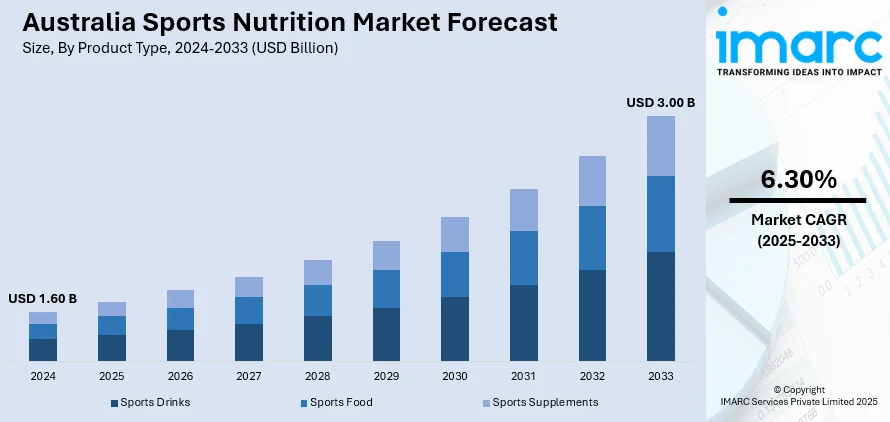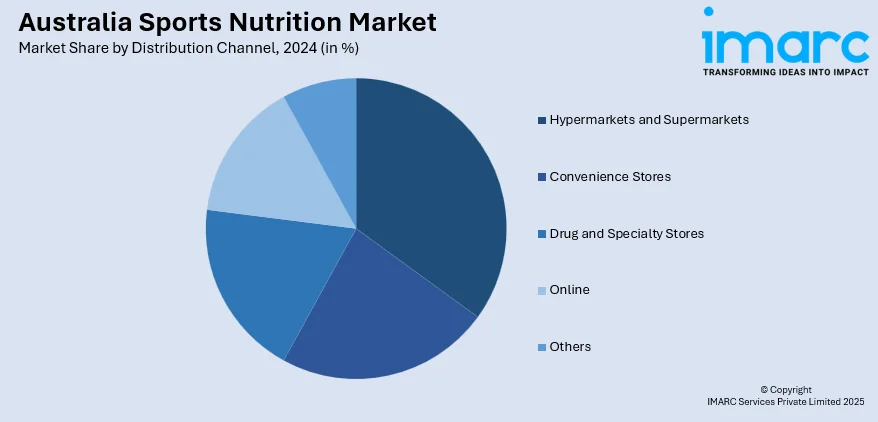
Australia Sports Nutrition Market Size, Share, Trends and Forecast by Product Type, Raw Material, Distribution Channel, and Region, 2025-2033
Australia Sports Nutrition Market Overview:
The Australia sports nutrition market size reached USD 1.60 Billion in 2024. Looking forward, IMARC Group expects the market to reach USD 3.00 Billion by 2033, exhibiting a growth rate (CAGR) of 6.30% during 2025-2033. The rising health and fitness awareness, increasing demand for protein-based products, the popularity of fitness regimes, innovations in product formulations catering to specific needs like plant-based and performance-enhancing supplements, and the growing consumer interest in sustainable and natural ingredients are propelling the market growth.
|
Report Attribute
|
Key Statistics
|
|---|---|
|
Base Year
|
2024
|
|
Forecast Years
|
2025-2033
|
|
Historical Years
|
2019-2024
|
| Market Size in 2024 | USD 1.60 Billion |
| Market Forecast in 2033 | USD 3.00 Billion |
| Market Growth Rate 2025-2033 | 6.30% |
Australia Sports Nutrition Market Trends:
Shift Towards Plant-Based Sports Nutrition Products
A major trend driving the growth of the Australian sports nutrition market is the rising demand for plant-based products. As consumers become more conscious of health, sustainability, and ethical issues related to animal-derived ingredients, plant-based alternatives are increasingly favored. This shift is in line with broader dietary trends like veganism and vegetarianism, as well as concerns over the environmental impact of animal farming. Plant-based proteins, such as pea protein, brown rice protein, hemp, and soy, are gaining popularity, especially among athletes and fitness enthusiasts seeking clean, sustainable, and easily digestible protein. These products provide similar nutritional benefits to animal-based options while meeting the demand for gluten-free, dairy-free, and non-GMO choices. Beyond athletes, plant-based sports nutrition also appeals to health-conscious consumers and those with dietary restrictions, capitalizing on the growing preference for clean-label, sustainable, and ethically produced products.

To get more information on this market, Request Sample
Personalization and Functionalization of Sports Nutrition Products
A key trend fueling the growth of the Australian sports nutrition market is the increasing demand for personalized and functional products. Consumers are now seeking sports nutrition solutions tailored to their specific health and performance goals, such as weight management, muscle recovery, energy enhancement, and endurance optimization. A growing number of Australian consumers are more likely to purchase sports nutrition products offering personalized benefits, highlighting the shift toward customized solutions. This trend is supported by technological advancements, such as wearable devices and fitness tracking apps, alongside DNA-based dietary recommendations. In response, companies are developing specialized products with added functional ingredients, like probiotics for gut health, adaptogens for stress management, and antioxidants for recovery. Personalized supplements tailored to specific fitness goals—such as weight management, muscle building, or enhanced endurance—are gaining traction as consumers shift away from generic solutions and increasingly seek products that align with their unique health and performance needs.
Australia Sports Nutrition Market Segmentation:
IMARC Group provides an analysis of the key trends in each segment of the market, along with forecasts at the region/country level for 2025-2033. Our report has categorized the market based on product type, raw material, and distribution channel.
Product Type Insights:
- Sports Drinks
- Sports Food
- Sports Supplements
The report has provided a detailed breakup and analysis of the market based on the product type. This includes sports drinks, sports food, and sports supplements.
Raw Material Insights:
- Animal Derived
- Plant-Based
- Mixed
A detailed breakup and analysis of the market based on the raw material have also been provided in the report. This includes animal derived, plant-based, and mixed.
Distribution Channel Insights:

- Hypermarkets and Supermarkets
- Convenience Stores
- Drug and Specialty Stores
- Online
- Others
The report has provided a detailed breakup and analysis of the market based on the distribution channel. This includes hypermarkets and supermarkets, convenience stores, drug and specialty stores, online, and others.
Regional Insights:
- Australia Capital Territory & New South Wales
- Victoria & Tasmania
- Queensland
- Northern Territory & Southern Australia
- Western Australia
The report has also provided a comprehensive analysis of all the major regional markets, which include Australia Capital Territory & New South Wales, Victoria & Tasmania, Queensland, Northern Territory & Southern Australia, and Western Australia.
Competitive Landscape:
The market research report has also provided a comprehensive analysis of the competitive landscape. Competitive analysis such as market structure, key player positioning, top winning strategies, competitive dashboard, and company evaluation quadrant has been covered in the report. Also, detailed profiles of all major companies have been provided.
Australia Sports Nutrition Market News:
- May 2024: Fixx Nutrition introduced new energy gel flavors ahead of the 2024 Gold Coast Marathon. The Fixx Gel X Pro range features all-natural, vegan, and gluten-free options, including Vanilla-Maple, Raspberry Fizz, and Pear Cider.
- April 2024: Vitaco Health launched Athena Sports Nutrition in Australia, with a dedicated focus on female athletes. Tailored with ingredients like iron, collagen, and calcium, Athena addresses women’s unique performance needs.
Australia Sports Nutrition Market Report Coverage:
| Report Features | Details |
|---|---|
| Base Year of the Analysis | 2024 |
| Historical Period | 2019-2024 |
| Forecast Period | 2025-2033 |
| Units | Billion USD |
| Scope of the Report |
Exploration of Historical Trends and Market Outlook, Industry Catalysts and Challenges, Segment-Wise Historical and Future Market Assessment:
|
| Product Types Covered | Sports Drinks, Sports Food, Sports Supplements |
| Raw Materials Covered | Animal Derived, Plant-Based, Mixed |
| Distribution Channels Covered | Hypermarkets and Supermarkets, Convenience Stores, Drug and Specialty Stores, Online, Others |
| Regions Covered | Australia Capital Territory & New South Wales, Victoria & Tasmania, Queensland, Northern Territory & Southern Australia, Western Australia |
| Customization Scope | 10% Free Customization |
| Post-Sale Analyst Support | 10-12 Weeks |
| Delivery Format | PDF and Excel through Email (We can also provide the editable version of the report in PPT/Word format on special request) |
Key Questions Answered in This Report:
- How has the Australia sports nutrition market performed so far and how will it perform in the coming years?
- What is the breakup of the Australia sports nutrition market on the basis of product type?
- What is the breakup of the Australia sports nutrition market on the basis of raw material?
- What is the breakup of the Australia sports nutrition market on the basis of distribution channel?
- What are the various stages in the value chain of the Australia sports nutrition market?
- What are the key driving factors and challenges in the Australia sports nutrition?
- What is the structure of the Australia sports nutrition market and who are the key players?
- What is the degree of competition in the Australia sports nutrition market?
Key Benefits for Stakeholders:
- IMARC’s industry report offers a comprehensive quantitative analysis of various market segments, historical and current market trends, market forecasts, and dynamics of the Australia sports nutrition market from 2019-2033.
- The research report provides the latest information on the market drivers, challenges, and opportunities in the Australia sports nutrition market.
- Porter's five forces analysis assist stakeholders in assessing the impact of new entrants, competitive rivalry, supplier power, buyer power, and the threat of substitution. It helps stakeholders to analyze the level of competition within the Australia sports nutrition industry and its attractiveness.
- Competitive landscape allows stakeholders to understand their competitive environment and provides an insight into the current positions of key players in the market.
Need more help?
- Speak to our experienced analysts for insights on the current market scenarios.
- Include additional segments and countries to customize the report as per your requirement.
- Gain an unparalleled competitive advantage in your domain by understanding how to utilize the report and positively impacting your operations and revenue.
- For further assistance, please connect with our analysts.
 Request Customization
Request Customization
 Speak to an Analyst
Speak to an Analyst
 Request Brochure
Request Brochure
 Inquire Before Buying
Inquire Before Buying




.webp)




.webp)












